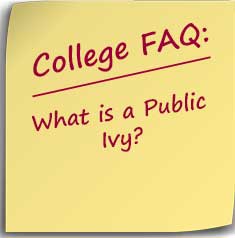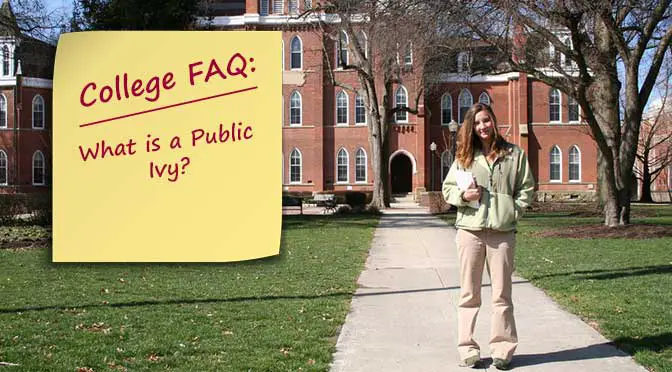 The term “Public Ivy” was coined by Richard Moll in Public Ivies: A Guide to America’s Best Public Undergraduate Colleges and Universities which was published in 1985. Moll identified eight public institutions with Ivy League characteristics. He argued that these characteristics, which included both academic and non-academic elements, provided an Ivy League experience at a public-school price. Since then, others have added to the list or often just use the term to describe a public institution with high academic standards.
The term “Public Ivy” was coined by Richard Moll in Public Ivies: A Guide to America’s Best Public Undergraduate Colleges and Universities which was published in 1985. Moll identified eight public institutions with Ivy League characteristics. He argued that these characteristics, which included both academic and non-academic elements, provided an Ivy League experience at a public-school price. Since then, others have added to the list or often just use the term to describe a public institution with high academic standards.
Download FREE list of public and original Ivies with
testing data, % Pell grants, and more!
Original Public Ivies
Moll had selected eight specific public institutions to compare with the eight Ivy League institutions in an attempt to capture the fact that “prestige in higher education is an odd combination of tradition and folklore.” The original eight Public Ivies were:
- College of William & Mary
- Miami University (Ohio)
- University of California-Berkeley
- University of Michigan
- University of North Carolina at Chapel Hill
- University of Texas at Austin
- University of Vermont
- University of Virginia
According to the Los Angeles Times, Moll determined the criteria for a distinctive college to be “selective admissions, a quality education program focused on the liberal arts and enough money to buy a superb faculty and build an attractive campus.” Moll created his list based on these criteria and then consulting with others and visiting campuses.
Expanded Public Ivies
Moll included nine “runner-up” universities:
- University of Colorado
- Georgia Tech
- University of Illinois
- New College in Florida
- Penn State
- University of Pittsburgh
- State University of New York at Binghamton
- University of Washington
- University of Wisconsin
Others have since expanded this list. Howard and Matthew Greene added eleven universities to the list. They also created a list of 30 “hidden” public ivies. You can see all the schools on Moll’s and Greeens’ lists on the table at the end of the post.
Part of the appeal of the public ivies is that they are public. This meant that the price, for in-state students at least, is significantly lower than that of the original, private Ivy league schools. Also, there is a general belief that public universities are more accessible and provide more economic and racial/ethnic diversity. However, if that even was the case when Moll first created his list, the differences have been growing smaller over time.
Do Public Ivies Cost Less?
Let’s start with costs. The original Ivies’ price tags are still some of the highest in the country. However, they also all pledge to meet 100% of demonstrated financial need, something none of the public Ivies can claim. Their financial aid packages also do not rely on student loans. If low- and middle-income students manage to get accepted to the original Ivies, they are likely to pay less than attending many public Ivies.
The public Ivies are not necessarily as accessible as they once were. While students still have much better odds at being accepted at a public Ivy compared to an original Ivy, they aren’t as good as they use to be. The University of Texas’ acceptance rate has dropped 64% in 2001 to 29% in 2021. The University of Michigan also became significantly more difficult to attend with its acceptance rate going from 52% in 2001 to just 20% in 2021. A total of six schools saw decreases of 30% or more including Georgia Tech, that only admitted 16% in 2021 compared to 54% in 2001.
Are Public Ivies More Diverse?
In terms of economic diversity, the public Ivies have a higher percentage of freshman with Pell grants compared to the original Ivies. Harvard had the highest percentage at 22%. Eleven public Ivies had higher percentages with three schools, UC Irvine, New College, and UC Davis all being above 30%. However, while five of the original Ivies had percentages below 20% so did 17 of the public Ivies on the list below.
The University of California schools along with the University of Washington are the most racially and ethnically diverse. However, the original Ivy league schools are not far behind. In fact, the original Ivies are all more diverse than 21 of the public Ivies.
Why Public Ivies?
Since Moll created his first list of public Ivies, there have been many others who have created their own version of public Ivies to consider. The important thing to keep in mind is that these lists of public Ivies are really no more or less legitimate than Moll’s original list or even the Ancient Eight original Ivies. After all, the Ivy League is actually just an athletic organization that has been around a long time and many of their advantages can be attributed to their longevity.
The following is a list of public Ivies based on Moll’s and Greene’s lists. You can download a PDF that includes the original Ivies that contains additional information such as test data and financial aid information here.
Public Ivies
Download Public and Original Ivies.
| Name | State | Moll’s Original | Moll’s Runner Ups | Greene’s Guide | Full-time Under-grads | 4 yr Grad-uation Rate | % Admitted | % Enrolled | Total price for in-state students 2021-22 | Total price for out-of-state students 2021-22 |
| University of Arizona | AZ | x | 30,238 | 50 | 87 | 20 | $30,686 | $55,208 | ||
| University of California-Berkeley | CA | x | x | 30,385 | 79 | 14 | 43 | $41,473 | $71,227 | |
| University of California-Davis | CA | x | 31,201 | 62 | 49 | 18 | $37,603 | $67,357 | ||
| University of California-Irvine | CA | x | 29,867 | 68 | 29 | 21 | $36,302 | $66,056 | ||
| University of California-Los Angeles | CA | x | 32,325 | 83 | 11 | 44 | $36,297 | $66,051 | ||
| University of California-San Diego | CA | x | 31,746 | 73 | 34 | 19 | $36,160 | $65,914 | ||
| University of California-Santa Barbara | CA | x | 23,527 | 70 | 29 | 16 | $37,720 | $67,474 | ||
| University of Colorado Boulder | CO | x | x | 25,222 | 53 | 80 | 16 | $32,351 | $58,169 | |
| University of Connecticut | CT | x | 18,551 | 72 | 56 | 18 | $35,764 | $58,432 | ||
| University of Delaware | DE | x | 18,512 | 73 | 72 | 19 | $31,562 | $53,422 | ||
| New College of Florida | FL | x | 673 | 58 | 74 | 13 | $21,928 | $44,956 | ||
| University of Florida | FL | x | 33,060 | 72 | 30 | 44 | $21,431 | $43,709 | ||
| Georgia Institute of Technology | GA | x | 15,376 | 51 | 16 | 49 | $29,802 | $50,914 | ||
| University of Georgia | GA | x | 29,542 | 68 | 40 | 37 | $27,946 | $46,986 | ||
| University of Illinois Urbana-Champaign | IL | x | x | 32,876 | 71 | 60 | 29 | $31,636 | $49,086 | |
| Indiana University-Bloomington | IN | x | 32,282 | 69 | 85 | 24 | $27,299 | $54,318 | ||
| University of Iowa | IA | x | 20,732 | 56 | 86 | 23 | $26,358 | $48,321 | ||
| University of Maryland-College Park | MD | x | 29,809 | 72 | 52 | 23 | $28,075 | $55,756 | ||
| Michigan State University | MI | x | 35,692 | 59 | 83 | 22 | $29,734 | $55,546 | ||
| University of Michigan-Ann Arbor | MI | x | x | 30,681 | 81 | 20 | 45 | $32,272 | $69,326 | |
| University of Minnesota-Twin Cities | MN | x | 28,587 | 72 | 73 | 26 | $29,416 | $47,980 | ||
| Rutgers University-New Brunswick | NJ | x | 36,132 | 68 | 68 | 24 | $34,130 | $51,331 | ||
| Binghamton University | NY | x | x | 14,607 | 75 | 44 | 18 | $29,454 | $45,484 | |
| University of North Carolina at Chapel Hill | NC | x | x | 18,756 | 84 | 20 | 45 | $24,770 | $52,633 | |
| Miami University-Oxford | OH | x | x | 16,459 | 73 | 89 | 17 | $35,642 | $56,317 | |
| Ohio State University-Main Campus | OH | x | 44,327 | 67 | 57 | 25 | $29,022 | $52,105 | ||
| The Pennsylvania State University | PA | x | x | 67,296 | 55 | 92 | 18 | $38,270 | $55,848 | |
| University of Pittsburgh-Pittsburgh Campus | PA | x | 18,927 | 69 | 67 | 21 | $36,400 | $51,432 | ||
| The University of Texas at Austin | TX | x | x | 38,500 | 70 | 29 | 48 | $29,788 | $59,032 | |
| University of Vermont | VT | x | x | 10,637 | 70 | 64 | 18 | $35,654 | $60,542 | |
| University of Virginia-Main Campus | VA | x | x | 17,173 | 89 | 21 | 39 | $36,314 | $70,696 | |
| William & Mary | VA | x | x | 6,393 | 86 | 37 | 26 | $40,624 | $63,850 | |
| University of Washington-Seattle Campus | WA | x | x | 30,671 | 71 | 53 | 28 | $30,640 | $58,470 | |
| University of Wisconsin-Madison | WI | x | x | 30,720 | 69 | 60 | 26 | $27,418 | $55,306 |



3 thoughts on “FAQ: What are Public Ivies?”